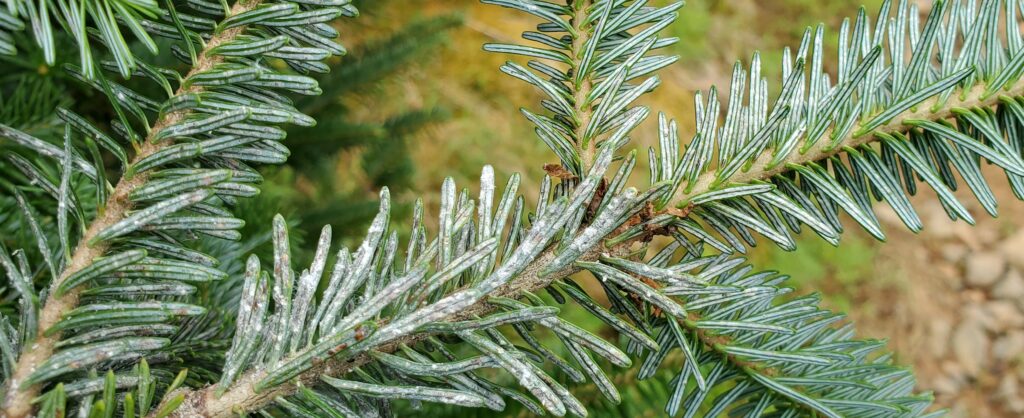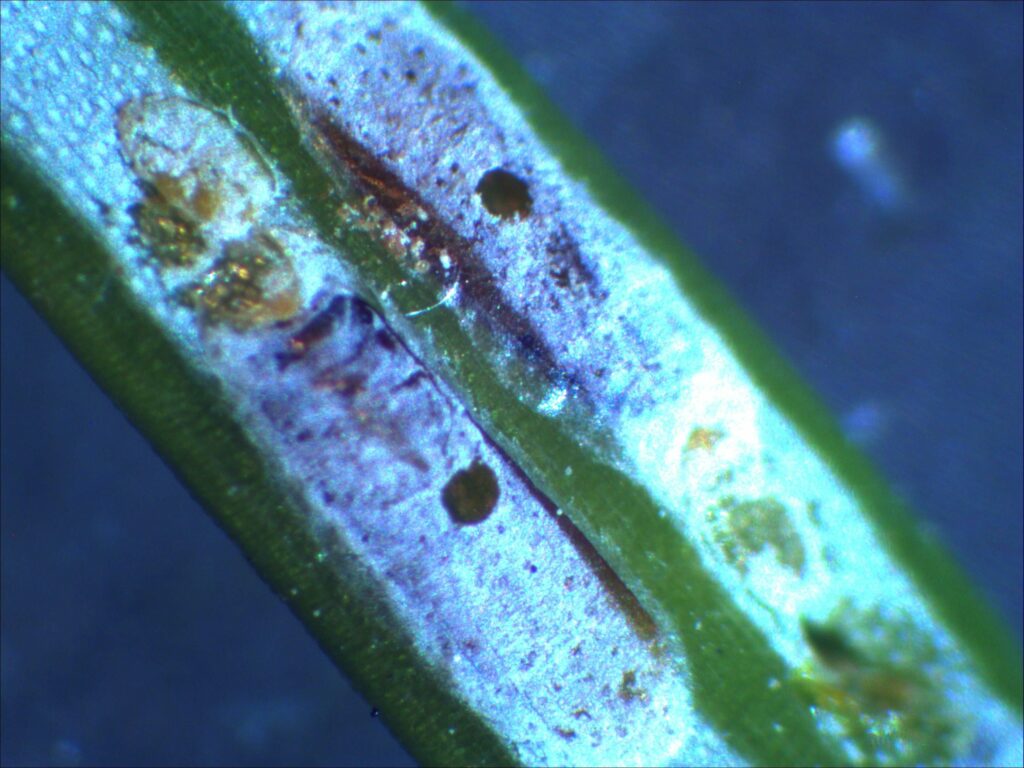Scouting for Elongate Hemlock Scale
go.ncsu.edu/readext?792398
en Español / em Português
El inglés es el idioma de control de esta página. En la medida en que haya algún conflicto entre la traducción al inglés y la traducción, el inglés prevalece.
Al hacer clic en el enlace de traducción se activa un servicio de traducción gratuito para convertir la página al español. Al igual que con cualquier traducción por Internet, la conversión no es sensible al contexto y puede que no traduzca el texto en su significado original. NC State Extension no garantiza la exactitud del texto traducido. Por favor, tenga en cuenta que algunas aplicaciones y/o servicios pueden no funcionar como se espera cuando se traducen.
Português
Inglês é o idioma de controle desta página. Na medida que haja algum conflito entre o texto original em Inglês e a tradução, o Inglês prevalece.
Ao clicar no link de tradução, um serviço gratuito de tradução será ativado para converter a página para o Português. Como em qualquer tradução pela internet, a conversão não é sensivel ao contexto e pode não ocorrer a tradução para o significado orginal. O serviço de Extensão da Carolina do Norte (NC State Extension) não garante a exatidão do texto traduzido. Por favor, observe que algumas funções ou serviços podem não funcionar como esperado após a tradução.
English
English is the controlling language of this page. To the extent there is any conflict between the English text and the translation, English controls.
Clicking on the translation link activates a free translation service to convert the page to Spanish. As with any Internet translation, the conversion is not context-sensitive and may not translate the text to its original meaning. NC State Extension does not guarantee the accuracy of the translated text. Please note that some applications and/or services may not function as expected when translated.
Collapse ▲Scientific name: Fioirnia externa
Where from: Introduced pest from Asia
Type of pest: Issue with marketing/regulatory action when shipping to areas where this pest is not found.

Branch heavily infested with elongate hemlock scale on multiple years of growth.
Pest description:
- Crawlers are pale yellow and oblong and crawl on foliage. With a magnifying lens, the eyes can be seen as two tiny black dots. They also have tiny antennae. Crawlers settle on needles underneath the white wax covering the back of the needle.
- Immature scales are yellow and oblong. The feeding tube is imbedded in the needle and, under magnification, can be seen as a thin, copper thread if the scale is flipped over on its top.
- Adult female scales are oblong and brown. The original yellow nymph is still found at one end. When half of a female scale is brown and the other half yellow, you are seeing the eggs inside the female scale.
- Immature male scales are oblong, white and produce white filaments to protect themselves. The body of the scale itself is orange with two large black spots were eyes are developing at the head.
- Adult males are a small, orange insect with long antennas and clear wings that fold over the top of their body. They have large black eyes. They have no mouthparts as they do not feed.
Damage to tree:
- Scale feeding can cause mottled foliage – yellow blotches on otherwise green needles in a pattern that resembles camouflage. However, scales can be present on needles without causing mottling.
- The white filaments produced by the immature males can be seen on the top of needles during periods of peak male production.

Elongate hemlock scale males
- In the southeastern US, elongate hemlock scale can be found on true firs, Douglas fir, hemlocks, Atlas cedar, and occasionally Mugo pine.
Where found in field:
- Scale incidence in the field may be associated with infested hemlocks in field borders or near older Frasers that are infested with scales.
- Scale incidence is typically spotty initially. Gradually the majority of trees in a field can be infested.
Where found in the tree:
- Found on underside of needles.
- Found on multiple years of growth, and therefore back in the canopy of the tree.
- More found lower on trees, but with heavy infestations, even the terminal may have scales.
Scouting method:
- Thorough scouting for elongate hemlock scale: To follow scale progress in blocks through the rotation, each year scout for scales by examining at least 15 trees per block. Lift up branches, starting at the bottom and working your way to the top of the tree. Look at the underside of branches for scales examining needles that are one to three years old. Vary the side of the tree you examine as you walk through the field. Keep track of the number of trees examined and the number of trees with scale. Also take note of how severe the infestation is and if scales are on the most current growth.
- Finding scale when scouting for twig aphids: When beating foliage over a plate to look for twig aphids, also keep track if scales are found. Yellow scales that fall onto the plate are most likely developing male scales. They will have two large black spots where eyes are developing.
- Finding scale when shearing/tagging: Anyone who works in Christmas trees should know the basic symptoms of elongate hemlock scale which includes mottled foliage and white discoloration of the needles due to the male scale. They should either tag those trees for others to investigate, or look at the underside of needles for the scale itself.
- Finding scale when shearing/tagging: Anyone who works in Christmas trees should know the basic symptoms of elongate hemlock scale which includes mottled foliage and white discoloration of the needles due to the male scale. They should either tag those trees for others to investigate, or look at the underside of needles for the scale itself.
How weather affects:
- Following winters with prolonged periods of bitter cold, scale populations appear to be reduced since nymphs don’t survive well.
- Warm falls and winters promote the increase of scale incidence and spread in the field.
How to develop treatment threshold:
- When selling to markets with zero tolerance for scales, control must be near complete. Treating preventively through the rotation is required.
- For other markets, as long as trees are growing well and not discolored, there may be less need to control scale. However, before trees are cut, it may be necessary to treat them with an insecticide so the male scale doesn’t become active and cause concern for the consumer once the tree is displayed at room temperatures.
What can be confused with this pest/damage:
- Algae on needles can be confused with the male scale. To distinguish, look for scales on the underside of needles.
- Other kinds of scales will cause mottling of foliage including Cryptomeria scale and pine needle scale. The presence of any of these may also cause regulatory action, but timing of controls are different, so be sure get a correct identification. Elongate hemlock scale is also much harder to control than these other scale pests.

Emergence holes of parasitic wasp in elongate hemlock scales
Important natural enemies:
- Parasitic wasps, the primary one being Encarsia citrina, kill primarily female scales by laying an egg in them and consuming them as the wasp larva develops inside. A round hole can be found in scales that have been parasitized from the mature wasp leaving the scale. Examination under a microscope may reveal the developing wasp inside the scale.
- Dusty wings.
- Certain species of lacewing have been observed feeding on scales. These may take the filaments produced by the males and place them on their own backs for protection.
- Lady beetle adults and their larvae feed on scales. The most important species is the twice-stabbed lady beetles. In addition, small black lady beetles have been observed feeding on scales.
For more information on the elongate hemlock scale including photographs and control recommendations see Scales in Christmas Trees.
For the complete Fraser fir scouting manual for western North Carolina, see Scouting Manual.


